Introduction
Choosing the right color for your roof is not just about aesthetics. While it certainly contributes to your home’s visual appeal, the color of your roof can also significantly impact your home’s energy efficiency, resale value, and overall lifespan. A well-chosen color can reflect heat, saving you significant amounts on your energy bills, while a poorly chosen color can lead to premature aging of your roof, costing you more in the long run.
Therefore, it is crucial to understand the importance of choosing the right color for your roof. When it comes to selecting the right roof color, several factors come into play. These include the climate in which you live, the architectural style and color of your home, local homeowner association rules, and your personal aesthetic preferences.
In regions with a hot climate, lighter colors that reflect heat are preferred, while in colder regions, darker colors that absorb heat are more suitable. The style and color of your home should also influence your choice, as the roof should complement and enhance your home’s overall look rather than clash with it. If you live in a neighborhood with a homeowners association, ensure you’re aware of any restrictions they may have regarding roof colors. Lastly, your tastes matter, but they should be balanced with the other factors to ensure a wise decision.
Understanding the Basics of Color Theory
What is Color Theory
In the realm of color theory, understanding the basics can significantly influence your roofing decision. Color theory, in essence, is a collection of rules and guidelines that designers use to communicate with users through appealing color schemes. This applies to roofing as well. The color of your roof can project a particular feel or mood, much like how a designer uses color to evoke a particular emotional response. A bright red roof may seem energetic and vibrant, while a dark blue roof might convey a sense of calm and stability.
The Impact of Color on Mood and Aesthetics
The impact of color on mood and aesthetics is a crucial factor to consider when choosing your roof color. Color can set the tone and feel of your home. For instance, lighter colors often make a home seem more inviting and cheerful, whereas darker colors can give off a more traditional, elegant vibe. The color of your roof can also complement or contrast with the rest of your house’s color scheme, thereby affecting the overall aesthetic appeal of your home.
The Color Manipulation of the Perceived Size and Shape
Additionally, the color of your roof can manipulate the perceived size and shape of your home. Lighter colors tend to make a house appear larger, while darker colors can make it seem smaller but more substantial. For example, a light-colored roof can help a small house seem larger, while a dark-colored roof can make a tall house appear less overwhelming. Therefore, understanding color theory can assist you in choosing a roof color that enhances your home’s aesthetic appeal and complements its architectural style.
Consideration of Climate and Geography
The Climate
Moving from understanding color theory, it’s time to delve into the practical considerations when choosing your roof color. One such critical factor is the climate in which your home resides. The color of your roof can play a significant role in your home’s energy efficiency. Lighter colors, for example, tend to reflect sunlight, keeping your home cooler in hot climates. In contrast, darker roof colors can absorb heat, making them ideal for homes in colder climates as they can help keep your home warmer. That’s why it’s crucial to consider the effect of climate on color choice.
Your Local Geography
In addition to climate, your local geography can also influence your roof color decision. If your home is surrounded by natural features such as forests, mountains, or bodies of water, choosing a color that harmonizes with these elements can create a visually pleasing effect. For example, a green or brown roof can complement a home in a forested area, while a blue or grey roof might be more suitable for a home near the sea. Similarly, consider the common colors used in your neighborhood. You might want to choose a color that blends in for a more unified look, or you might prefer a color that stands out to give your home a unique identity.
The Intensity and Angle of Sunlight
Lastly, the intensity and angle of sunlight in your area play a pivotal role in color perception. The same color can look vastly different under intense sunlight compared to under cloudy conditions. For areas with high sunlight intensity, consider choosing a color that won’t fade easily.
Also, remember that colors can appear lighter under direct sunlight. So, if you want a particular shade, you might need to choose a slightly darker color to achieve your desired look during bright, sunny days. It’s always a good idea to view color samples under different lighting conditions before making your final decision.
Architectural Style and Historical Accuracy
Moving on from the climatic and geographical factors, an equally important consideration when choosing the right color for your roof is the architectural style of your home. This is because different architectural styles tend to have distinct color palettes that work best with their unique design features. For instance, Victorian homes are often paired with complex color schemes, including multi-colored roofs, to highlight their ornate detailing. On the other hand, modern homes tend to favor monochromatic color schemes, with flat roofs often painted in shades of black, white, or gray.
Historical Style
Moreover, if your home is of a particular historical style, maintaining historical accuracy can be vital. This not only preserves the integrity of the architectural style but also adds to the overall aesthetic appeal and market value of the home. For example, Colonial-style homes often feature dark, muted tones such as black, gray, or navy, which were popular during the period. Similarly, Mediterranean-style homes typically have red or terracotta-colored roofs, reflecting the traditional clay tiles used in the region.
Examples of Color Schemes for Different Architectural Styles
Lastly, let’s delve into some examples of color schemes for different architectural styles. For Craftsman-style homes, earthy tones like brown, green, or red can be an excellent choice, reflecting the natural materials often used in their construction.
Meanwhile, for beach-style homes, light, bright colors such as white, blue, or sandy tones can provide a fresh and breezy aesthetic that complements the surrounding seascape.
In the case of Ranch-style homes, classic hues like gray, brown, or tan can provide a timeless look that harmonizes well with their simplistic, grounded design.
Neighborhood Rules and Regulations
Transitioning from the architectural style of your home, another vital aspect to consider when choosing the right roof color is the rules and regulations set by your neighborhood or homeowner’s association. These regulations are often established to maintain a certain aesthetic or visual harmony throughout the community. For instance, if you live in a neighborhood with colonial-style homes, the association may have rules about using traditional colors like black, brown, or gray for the roofs.
Understanding These Rules
Understanding these rules is the first step to navigating them while still finding a color you love. Begin by getting a copy of these guidelines from your association. They usually provide a range of acceptable colors or color families to choose from. If your favorite color is within this range, you’re in luck! If not, don’t fret just yet. Remember, the goal of these regulations is to maintain a cohesive aesthetic appeal in the neighborhood.
Consider its Impact on the Overall Look
Therefore, if you have a color in mind that isn’t on the approved list, consider its impact on the overall look of your home and the neighborhood. If your chosen color still aligns with the aesthetic without disrupting the harmony, you may be able to request an exception. Keep in mind that while the rules may seem restrictive, they are there for a reason.
A well-balanced, harmonious neighborhood can be a pleasant sight and potentially increase the value of your home. By understanding and working within these regulations, you can still find a roof color that you love and that enhances the beauty of your home and the community.
Energy Efficiency
Moving beyond the neighborhood and homeowner’s association rules, another crucial factor to consider when selecting a roof color is energy efficiency. The color of your roof can significantly affect your home’s energy consumption, especially in areas with extreme climates.
Light-Colored Roofs
Light-colored roofs, such as whites, creams, and even light blues, have reflective properties that help in bouncing back the sun’s rays. This is particularly beneficial in warmer regions where cooling costs are a major concern. These light shades act as natural insulators during summer, keeping your home cooler and reducing the need for air conditioning.
Dark-Colored Roofs
On the other hand, dark-colored roofs, such as deep blues, blacks, or browns, absorb more heat. This characteristic proves beneficial in colder climates, where the extra warmth can help reduce heating costs during winter. However, if you live in a region with fluctuating climates, a medium shade might be a good compromise. This way, your home can benefit from both the absorption and reflection properties of different colors.
Choosing the right color is a balance between aesthetics, regulations, and energy efficiency. Carefully evaluating all these factors will lead you to the perfect roof color for your home.
Durability and Maintenance
Moving on to durability and maintenance in consideration for choosing the right roof color, it’s important to note that different roof colors do indeed show varying degrees of wear and tear over time.
Light-colored roofs, while exceptional for energy efficiency, may show dirt, debris, and signs of weathering more prominently than darker roofs. This is because lighter colors tend to highlight the accumulation of dust, grime, and other pollutants that can gradually dull the surface. On the other hand, darker roofs are more likely to fade over time due to extended exposure to sunlight. Therefore, you may find yourself needing to replace or restore a dark roof sooner than a light one.
In terms of maintenance, there’s a direct correlation between roof color and the level of upkeep required. Light roofs, while they may show dirt more readily, are generally easier to clean due to their reflective properties. This means that a simple power wash can often restore them to their original color. Dark roofs, meanwhile, may require more frequent cleaning to prevent the build-up of heat-absorbing materials like moss and lichen, which can impact their ability to absorb heat effectively.
In essence, while the color of your roof can significantly impact the energy efficiency of your home, it also dictates the degree of maintenance required and the visual impact of wear and tear. It’s imperative to ensure that your choice of roof color aligns not only with your aesthetic preferences and local regulations but also with your willingness to undertake the necessary upkeep that different colors may demand.
Conclusion
In conclusion, selecting the right color for your roof is a decision that requires thoughtful consideration. It’s not just about picking a color that complements your home’s aesthetic appeal, but also one that contributes positively to the energy efficiency of your home ensures durability, and is easy to maintain. Remember, light-colored roofs may reflect sunlight and therefore are more energy efficient. However, they might require more maintenance as they can show dirt and weathering prominently. On the other hand, dark roofs may absorb more heat, which can be beneficial in colder climates, and they may hide dirt and signs of wear more effectively, but could require more frequent cleaning to maintain their heat-absorption effectiveness.
It’s also important to understand that every home is unique in its design, location, and surrounding environment. Therefore, what works best for one home may not necessarily be the most suitable for another. This is where professional advice becomes crucial. Roofing professionals have the experience and knowledge to guide you in making the best decision for your specific circumstances. They can help you strike the right balance between aesthetics, energy efficiency, durability, and maintenance.
So, don’t hesitate to reach out to a roofing professional for personalized advice when choosing the right roof color. Their guidance can help you avoid potential pitfalls and ensure that you make a choice that not only looks great but also stands the test of time and elements.
Name, Address, and Phone
Stanton RECC
7622 Colgate Ave, Westminster, California, 92683, US
714-451-4948
Social Media’s







